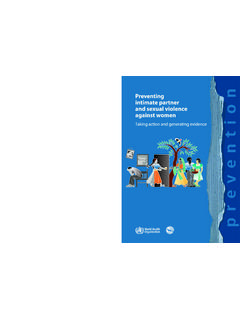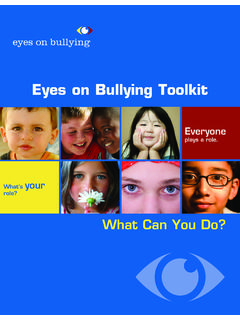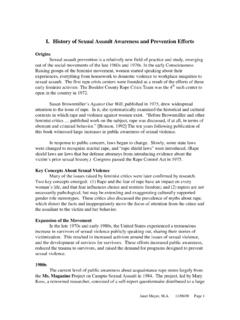Transcription of and well-being for all Unhealthy Lives - Donald Hirsch
1 Policy Implications: Tackling child poverty will raise health levels The facts show that links between poverty PSA 12: Improve the health PSA 18: Promote better health Unhealthy Lives and ill health go far beyond the immediate and well-being of children and well-being for all health effects of living on a low income. and young people As people's Lives unfold, the poor health Including the following key indicators: Including the following key indicators: associated with poverty limits their All age, all cause (AAACM). potential and has knock-on effects on the Breastfeeding at six to eight weeks mortality rate future Lives of those affected and of their Childhood obesity Gap in AAACM mortality rate in children. Repeated exposure of families Child emotional health and well-being disadvantaged areas to poverty intensifies this process. Reducing and eventually eliminating Smoking prevalence child poverty would break this cycle, with profound benefits for the health of PSA 13: Improve children and young people's safety An underlying objective of health policy today is to move more towards Intergenerational Links the population.
2 The same government that has as its stated objective the Including the following key indicators: preventing ill-health, rather than concentrating only on treatment and Between Child Poverty and Poor Health in the UK. Hospital admissions caused by halving of child poverty by 2010 and its cure. By intervening early in children's unintentional and deliberate injuries elimination by 2020 also has in its public Lives to eliminate the economic service agreements the following key Preventable child deaths deprivation that so badly damages objectives and indicators that would their health, we can take a major be addressed by reduction in child step towards meeting this goal. poverty (HMT 2007): What needs to be done: 1) Tackle Poverty to Prevent 3) Invest in Children as they Grow 1 in 3 children are living in poverty Ill-health School lunches (together with breakfast in the UK today. Child poverty is Poverty is the greatest preventable threat clubs) offer a great opportunity to ensure not inevitable, and progress has been to health, and tackling it is fundamental that all children, and particularly poorer made, but with one child in every three to addressing health inequalities and children, get a decent meal.
3 The Jamie still experiencing poverty we have an boosting life chances. The Government Oliver effect' focused minds on quality, urgent task on our hands. needs to invest an additional 3 billion now we need to improve access. Free The Campaign to End Child Poverty per year to help meet the interim target School Meal entitlement covers fewer is a coalition of more than 100 children's to halve child poverty by 2010. children than live in poverty, and even and other charities, child welfare then not all get their entitlements. Policy organisations, social justice groups, 2) Get it Right from Before makers need to tackle stigma which stops families claiming and start learning faith groups, trade unions, schools and the Start from the creative solutions of widening others concerned about the unacceptably Poverty damages children before birth high levels of child poverty in the UK. access (for instance to low income and increases the chances of being born all working together to eradicate families in work) being adopted by underweight, with major implications for child poverty.
4 The Scottish Executive and in Hull. mortality and morbidity risks throughout life. Investments made or proposed through child benefit (before birth) and 4) Break the Inverse Care Law This briefing is the latest in a series Poorer people have worse health yet of briefings on key Campaign areas, the new Health in Pregnancy grant are too often they get access to worse others include: very welcome. Alongside these the services more poorly funded and Government needs to improve income Child Poverty and Income, staffed. Policy makers should bend support scale rates to ensure an adequate spending more radically towards services Child Poverty and Education, minimum income in pregnancy. dealing with poorer communities and Child Poverty and Housing, and develop services better fitting different needs to detect ill-health earlier so Employment and Childcare. health care can be more effective. To learn about child poverty, take action and get involved in the Campaign, go to: Briefing by Donald Hirsch and Professor Nick Spencer, published by End Child Poverty with support from GMB.
5 Registered Charity no. 1099008. 2-3 16/5/08 10:09:04. Summary Babies In many parts of the world, large sections of the Babies suffer health penalties if they are born into population typically have short, Unhealthy Lives because disadvantaged families. Babies whose parents are in of poverty. In the UK today, there remain powerful links poverty have far greater risk of having low birthweight. between child poverty and poor health. This has implications both for the risk of infant mortality and for health problems in later life. Poverty affects children's This briefing presents evidence health before they are even of the poverty-health cycle, This briefing is based on data presented in born, and the compounded which is illustrated in the two papers written by Professor Spencer Birthweight of the University of Warwick. See: consequences of poverty diagram below. At each stage Babies in the 20% most 200g accounting for1/3 of Low birthweight at different ages influence of life, individuals' health can deprived areas have lower babies with low and with produces health risks average birthweight.
6 Through to adulthood. development throughout the be affected both by the direct very low birthweight*. Compared to Lives of those who grew up impact of poverty and by the poor. When they go on to have knock-on effects of health Babies in the In Summary: 20% least Based on comparisons of births in West Midlands, Spencer et al 1999. children of their own, these difficulties at an earlier stage. Poverty affects children's birthweight. deprived areas *Assuming average could be brought up to least deprived areas effects are passed to the One third of births with low weight are next generation. associated with economic inequalities. Infant Mortality Children face far greater health risks Children in if they are in disadvantaged families. poor families have 10 times the chance overall, they are twice as likely For example, they are ten times as likely to die at birth or in infancy, a gap that of dying suddenly in infancy. Poor has widened in recent years. to die suddenly in infancy, 2 times Compared to maternal health as likely to suffer chronic illness as toddlers, twice as likely to have Children in richer families Fleming et al, 2000 Howard et al 2001, ONS 2004.
7 Cerebral palsy and over three times as likely to suffer mental disorders. Adults who suffered poverty as children are 50% more likely to have Studies of birthweight in different This finding reflects the consequences of Infant mortality rates, measuring deaths limiting illnesses. Adults who had low Poor health at birth, low birthweight Poverty Health problems in adulthood birthweight are over four times as likely parts of the country have compared health inequalities all the way across the among under-1 year olds, are also much babies born in more and less deprived income distribution. Children in poverty higher among more deprived families . to have Type 2 diabetes (associated neighbourhoods. Those in the 20% have worse health than everyone else, about twice as high in the lowest than with obesity) and 25% more likely to most deprived areas typically have a but among those who are not in poverty, in the highest socio-economic group. die from heart disease. birthweight 200g lower than those in there is a continuous improvement Sudden unexpected death in infancy Mothers who grew up socially the 20% least deprived.
8 This creates among those with higher incomes. has decreased in recent years partly disadvantaged are one-third more a substantial extra risk of babies being in response to the Back to Sleep'. Health Closely associated with low birthweight, likely to smoke during pregnancy. of low or very low birthweight, which in campaign, advising mothers to sleep problems in stillbirths and mortality in the first week childhood They are also much more likely to be turn affects the chances of suffering their babies on their backs. However, of life are much higher in families with among those with low qualifications, ill health later in life. babies who die unexpectedly in infancy lower socio-economic status. Among who are more likely to smoke and are now more concentrated than ever in For example, a study in the West families with professional and managerial less likely to breastfeed. families on low incomes, who have ten Midlands showed that if all areas had occupations, this perinatal mortality.
9 Times the rate of sudden infant death This evidence has profound implications had the same birthweight pattern as the rate halved from 12 to 6 per thousand than families on relatively high incomes. for public policy. It suggests that effective 20% best-off areas, there would have births between 1979 and 1999, but action to tackle child poverty would make been 30 per cent fewer babies born among the least advantaged families an important long-term contribution to at below , and and 32 per it was still 11 per thousand in 1999. many health-related policy objectives, cent fewer below While the risk of dying at birth has including reducing obesity, reducing declined among all groups, the relative heart disease, increasing breast feeding risk for disadvantaged social groups and improving mental health. has risen. 1 2. 4-5 16/5/08 10:09:05. Children and Young People Children and young people growing up in disadvantaged Disability There are sharp differences in the and 1990s shows that children in The Height of Poverty Social historians have noticed strong families face worse physical and mental health, prevalence of childhood disability according to the socio-economic status the most deprived groups are twice as likely to suffer cerebral palsy as links between changes in a society's affluence and its average height.
10 And more disabilities of the household, with working class children having a higher risk of being those in the most privileged group. In modern Britain, adult height appears to be partly determined by the class- The same study shows that disabled than their better-off peers. developmental delay in early related rate of childhood growth Infant and childhood deaths Cerebral palsy is the most common childhood, particularly delay in (Wadsworth and Kuh, 1997). By the affect only a small minority Early Childhood Illness age of 10, one study showed children childhood physical disability. Data from speech and language, is associated of the population in developed 3-year-olds with social disadvantage. living in deprived areas about 5cm in families on West Sussex collected in the 1980s shorter on average than those in the countries, even among families < 10,400 (2003). 2 times as likely to suffer Compared to are accounting for42% of children least deprived areas (Reading et al in poverty.)








